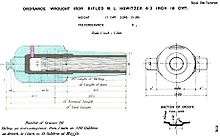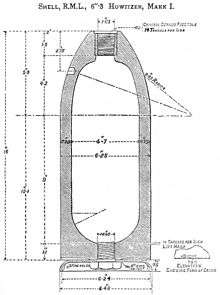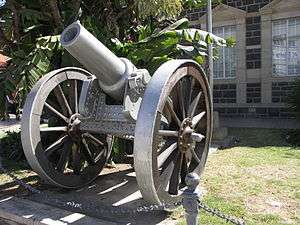RML 6.3-inch howitzer
| RML 6.3-inch howitzer | |
|---|---|
|
One of the two guns used during the Siege of Ladysmith | |
| Type | Howitzer |
| Place of origin |
|
| Service history | |
| Used by | British Empire |
| Wars | |
| Production history | |
| Produced | 1878[1] |
| Specifications | |
| Weight | 2,016 lb (914 kg) barrel[2] |
| Barrel length | 3 feet 9 inches (1.1 m) bore (7.14 calibres)[2] |
|
| |
| Shell | 70 lb (32 kg)[2] |
| Calibre | 6.3 inches (160 mm) |
| Action | RML |
| Traverse | nil |
| Muzzle velocity | 751 ft/s (229 m/s)[3] |
| Effective firing range | 4,000 yards (3,700 m)[1] |
The RML 6.3-inch howitzer was a British rifled muzzle-loading "siege" or "position" howitzer/mortar proposed in 1874 and finally introduced in 1878 as a lighter version of the successful 8-inch howitzer that could be carried by the existing 40-pounder gun carriage.[4]
By 1880 the RML 6.3-inch was superseded by a longer 6.6-inch howitzer with higher muzzle velocity.[5]
Description

The barrel consisted of an inner "A" tube of toughened mild steel, surrounded by wrought-iron "B" tube and jacket.
Rifling was of the "polygroove" type, with 20 grooves and a twist increasing from 1 turn in 100 calibres (i.e. 630 inches) to 1 in 35 (i.e. 220 inches).[4]
Operational use
Ten 6.3-inch Howitzers were landed in Egypt in 1882 to form part of a Royal Artillery Siege Train during the Anglo-Egyptian War, however they were not used in action.[6] Many were mounted in Forts and batteries around the United Kingdom as part of the fixed defences scheme. Most were dismounted and scrapped after 1902.
A number of RML 6.3-inch howitzers were used by the British forces during the Second Boer War, normally mounted on 40 pr RML carriages.[1]
Ammunition

The gun was the first British rifled muzzle-loader to dispense entirely with studs on shells to impart spin : its shells from the beginning had gas checks attached to their base which expanded and engaged with rifling on firing to impart spin to the shell.[4]
Surviving examples
- Two of these guns, called Castor and Pollux, used during the Siege of Ladysmith, stand in front of the Ladysmith town hall. They have been declared Heritage Objects by the South African Heritage Resource Agency.[7][8][9] Both the guns and their ammunition were outdated by the time of the siege and they tended to make a lot of smoke when fired.[10]
See also
Notes
- 1 2 3 Hall, Darrell (1971). "Guns in South Africa 1899-1902 Part V and VI". The South African Military History Society. Retrieved 2008-10-22.
- 1 2 3 Text Book of Gunnery 1902, Table XII Page 338.
- ↑ 751 ft/second firing 70 lb projectile, using 4 lb RLG2 (gunpowder) propellant. Text Book of Gunnery, 1902, Table XII page 338.
- 1 2 3 Treatise on Construction of Ordnance in the British Service, 1879, pages 79; 171; 259-260
- ↑ "The Gun - Rifled Ordnance: Howitzers". Royal New Zealand Artillery Association. Retrieved 2009-07-14.
- ↑ Goodrich, Caspar F (Lt Cdr), Report of the British Naval and Military Operations In Egypt 1882, Navy Department, Washington, 1885, p.231
- ↑ "9/2/415/0028 - Castor and Pollux 6 3 in. RML Howitzer Ladysmith". South African Heritage Resource Agency. Retrieved 28 August 2012.
- ↑ "Managing Heritage Objects that form part of the National Estate" (PDF). South African Heritage Resource Agency. 2005-07-15. Retrieved 2008-10-22.
- ↑ "Government Gazette Vol. 477" (PDF). Government of South Africa. 2005-03-30. p. 5. Retrieved 2008-10-22.
- ↑ Nevinson, H. W. Ladysmith - The Diary of a Siege. METHUEN & CO. p. 125. Retrieved 2008-10-22.
References
- Text Book of Gunnery, 1902. LONDON : PRINTED FOR HIS MAJESTY'S STATIONERY OFFICE, BY HARRISON AND SONS, ST. MARTIN'S LANE
- Treatise on the Construction and Manufacture of Ordnance in the British Service. War Office, UK, 1879
External links
| Wikimedia Commons has media related to RML 6.3 inch Howitzer. |
- Handbook for the 6.3 inch R. M. L. howitzer on bed and ground platform, or on siege travelling carriage, 1886 at State Library of Victoria
- History of the 6.3-inch RML ordnance
